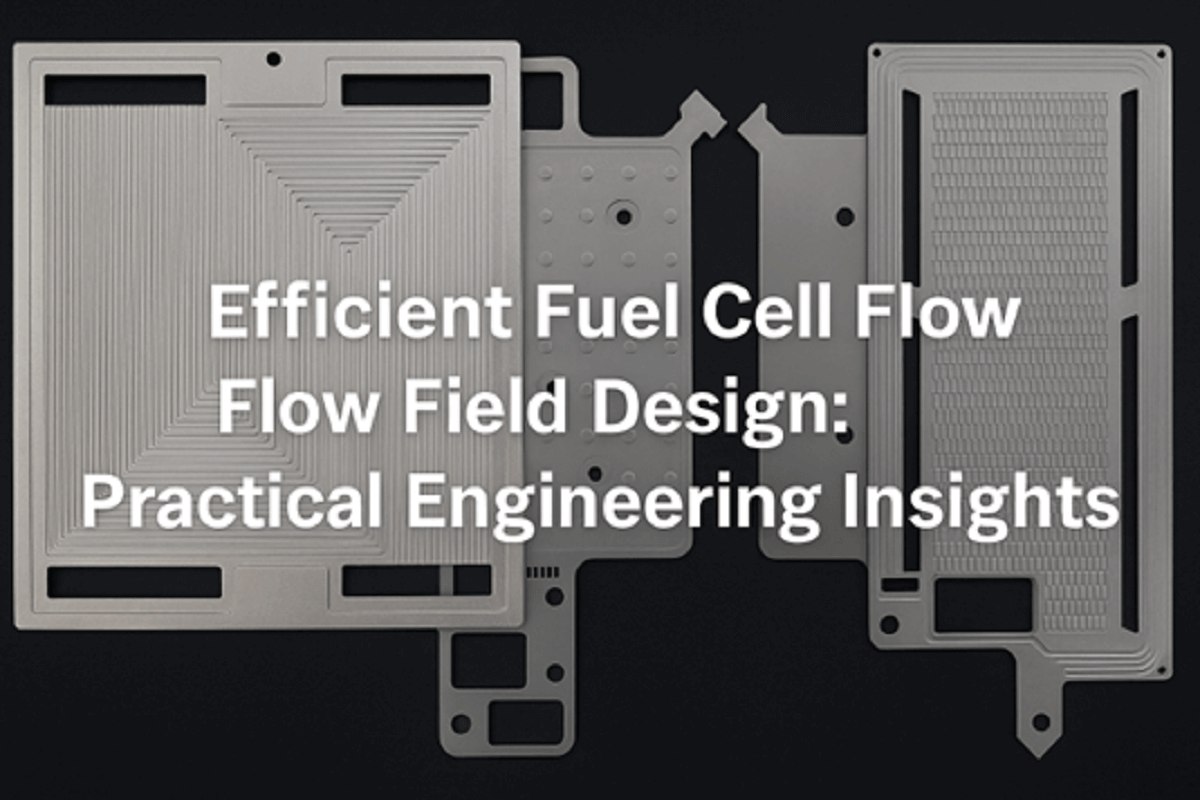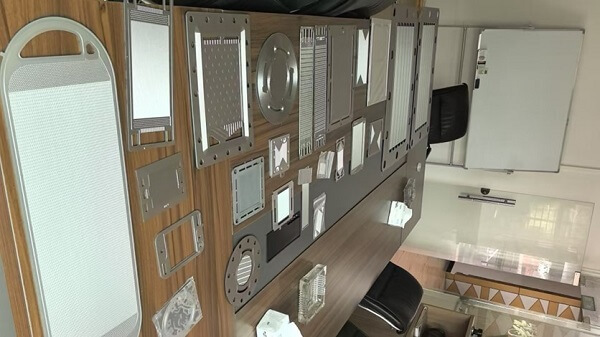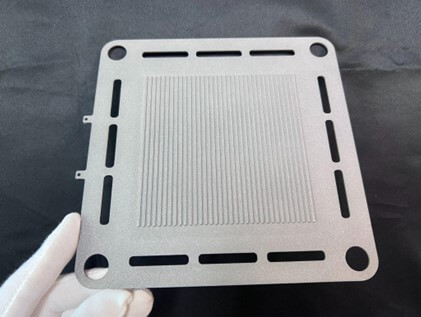Visualize your fuel cells project not performing or running hot due to an inconsistent fuel cell flow field design. Engineers often face these challenges when developing PEM systems for automotive or energy applications. That’s where TMNetch helps. If you plan to do PEM fuel cell flow field design and bipolar flow field design for PEM fuel cells, note the designs, materials, and techniques that will cater to the needs. The article discusses new efficient fuel cell flow field design guidelines and vectors that help professional engineers overcome their everyday difficulties to achieve optimal and consistent results.

Concept of The Flow Field Function and Geometry
The geometry of a fuel cell flow field design directly affects the distribution of gases and the removal of by-products like water. Engineers often leverage an advanced fuel cell flow field design geometry to enhance mass transfer and thermal equilibrium. For PEM cells serpentine and interdigitated conduits are the most widely used forms, which provide controlled pressure drops and excellent water management.
Optimized geometry ensures the current density across the surface of the fuel cell is even, and hotspots and heat transfer in cells occur more effectively. If designed in accordance with the efficient fuel cell flow field design guidelines, each channel and manifold is thought through in order to be able to regulate the flow uniformly along the active surface. Below we’ve listed some tips that might help you achieve efficiency.
1. Material Selection and Manufacturing Accuracy
For bipolar flow field design for PEM fuel cells, the choice of materials can influence the performance significantly. Graphite plates are the most effective in this regard as they are corrosion resistant and lightweight. On the other hand, metal plates with protective layers are excellent due to their high electrical conductivity and mechanical strength. The material must guarantee that it will be able to resist chemical breakdown at the same time maintaining the integrity of the contact.

The advanced manufacturing solutions, such as chemical etching and laser cutting, allow for the creation of flow channels that are optimized for fuel cell flow field design for PEM systems. The technology makes it easier to ensure that the metal or graphite plates feature micro-channels of equal dimension, which is important for even distribution of reactants and minimum resistance loss.
2. Balancing Gas Distribution and Water Management
Perhaps one of the biggest challenges associated with PEM fuel cell flow field design is water management. Too much moisture in the system results in flooding and low performance. Too little water, on the other hand, dries the membrane and hampers electrical conductivity. Thus, the main task of optimal fuel cell flow field design is to balance between hydration and drainage.
Currently, most designers solve the problem by introducing hydrophobic coatings for metal or structured outlet shapes. In addition, multi-path flows are used to balance the gas distribution and keep the humidity at a sufficient level. The idea of efficient fuel cell flow field design guidelines is to ensure that the cell operates in a stable way without degrading.
3. Pressure Drop and Flow Uniformity
In any advanced fuel cell flow field design geometry, achieving a balanced pressure drop across all channels ensures uniform flow delivery. A high-pressure drop increases mass transport but raises parasitic losses by forcing too much pressure; a low-pressure drop does not improve gas flow. In this regard, the application of computational fluid dynamics simulations is extensive. By analyzing virtual models of a bipolar flow field design for PEM fuel cells, engineers can ensure flow field optimization before testing on physical samples.

Besides decreasing the likelihood of shorts and even improving power output, uniform gas flow eliminates local hot spots. Given the numerous sources of recommendation for various optimized fuel cell flow field design for PEM combinations, the conclusion is that battery plates with power from these cells ensure a predictable flow regardless of the operating conditions.
4. Thermal Management and Durability
Reactions inside the fuel cells produce heat that should be managed to ensure membrane stability. Poor thermal capabilities result in potential local areas of high gradient that accelerate chemical instability and material decomposition across the fuel cell. Channels and additional thermally conductive plates are typically added to dissipate heat effectively.
Combining advanced fuel cell flow field design geometry with efficient heat dissipation steps means not only better efficiency but also longer component life. In the long term, durability depends on the certainty that the fuel cell will always operate in a relatively optimal thermal window.
5. Continuous Testing and Optimization
An efficient fuel cell flow field design is always a matter of a continuous improvement process. Typically, engineers use CFD modeling, experimental testing, real world performance data to keep fine tuning channel patterns, dimensions, and material combinations. Following the efficient fuel cell flow field design guidelines outlined above and running it in an iterative testing mode will help to achieve the ideal combination or low resistance, low power density, power operation.
There are multiple modern tools, allowing flowing PEM fuel cell flow field design simulations in multi scale mode, from a singe cell to a full stack cell leading to faster development time and ensuring good performance of the final product in any environment.
6. Common Problems to Avoid
Both experienced and beginner designers still have a rough time optimized fuel cell flow field design for PEM systems. The main mistakes to avoid are:

- Inconsistent channel depth is causing a pressure imbalance.
- Over complicated geometry calling for elevated manufacturing cost.
- Neglecting water drainage in bipolar flow field design for PEM fuel cells.
- Use of dissimilar materials leading to corrosion.
The above errors are partitions altogether, ensuring a smooth operation time for the part in question is extended.
Benefits of Optimized Flow Field Design
A refined fuel cell flow field design delivers measurable advantages:
- Enhanced Power Density: Better gas supply and regulation of heat, and controlled heat improve PEM fuel cell flow field design.
- Longer Lifespan: Better balanced humidity and gas distribution and control of heat lead to reduced membrane tension and improved bipolar flow field design for PEM fuel cells lifespan.
- Reduced Operation Expenses: The materials and designs are more reliable and reduce energy wastage, and maintenance in the optimized fuel cell flow field design for PEM system.
- Better Power Distribution: Better heat and gas distribution prevent hot areas in the fuel cell flow field design, and effective gas supply improves uniform power distribution.
- Improved Water Handling: Better designs will consist of places suitable for the maintenance of the necessary levels of moisture and power, leading to more uniform PEM fuel cell flow field design, and improved efficiencies.
Why You Should Choose TMNetch for Fuel Cell Flow Field Design

Choosing TMNetch gives fuel cell flow field design precision in product development. The user will be able to accumulate concept innovations of field flow designs that are proven beneficial by actual applications. Some of the benefits include:
- Specialization: With years of experience, the user will end up relying on PEM fuel cell flow field design to attain industrial and research requirements.
- Advanced Tools: We have well established chemical etchings and photo etchings to produce a tunneled bipolar flow field design for PEM fuel cells.
- Better Design: Our engineering team will ensure that the efficient fuel cell flow field design guidelines that increase the concentration of perfect gas, reduce resistance, and improve better management of water.
- Quality materials: All our materials are durable and made of corrosion metal and graphite composites to greatly improve resistance.
- Validation Techniques: All field designs are manually tested for consistency, uniformity, and long-term stability. This includes some demanding additivity with the partner relations always there to offer conclusive, detailed geometry.
Partnering with TMNetch means working with experts dedicated to advanced fuel cell flow field design geometry through innovation and precision.
FAQs
Q1. What is the purpose of PEM fuel cell flow field design?
Fuel cell flow field design is used to manage the distribution of reactant gases, water, and temperature control. Appropriate geometry helps increase the efficiency, decrease the loss, and improve the overall PEM fuel cell durability.
Q2. How does flow field geometry determine performance for a PEM fuel cell?
PEM fuel cell flow field design helps define how gas and water will move through the cell. Well-optimized features ensure even gas distribution, avoid flooding, and provide an extremely high degree of electrochemical efficiency and uniformity.
Q3. What are the main challenges in bipolar flow field design?
For bipolar flow field design, PEM fuel cells might have challenges, such as uneven gas distribution, uncontrolled and improper pressure balancing, and problematic corrosion. Advantages of handling and addressing templated design challenges ensure increased conduction within the cell.
Q4. Why do you think CFD simulations are used for fuel cells?
To be able to process and test an optimized fuel cell flow field design for PEM, it will need to be tested under a simulation that predicts gas flow, temperature, and humidity under different conditions without manufacturing. It is advantageous in that it saves time and cost with better results and higher precision than physical testing.
Summary.
Correlating your efficient fuel cell flow field design guidelines ensures optimized, efficient, and durable PEM fuel cell systems. By associating with us, you are partnering with an expert in fuel cell flow field design selection value to promote fuel cell technology development. TMNetch is a certified fuel cell flow field design products that provide less expensive and efficient power for a sustainable future.
